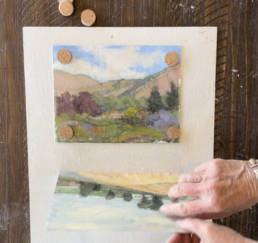 Now more than ever, artists are taking their art careers into their own hands. Here at Fine Art Tips, I am always on the lookout for fresh and helpful ideas to help artists improve their art sales.
Now more than ever, artists are taking their art careers into their own hands. Here at Fine Art Tips, I am always on the lookout for fresh and helpful ideas to help artists improve their art sales.
More artists are selling their work online. Have you ever thought of just making some art that people might like to buy (the kind your mother wishes you would make) and sell it on eBay? Who knows it could be a lucrative second career! Or perhaps you just love to photograph or paint anything and everything and you are are talented. People like your work. Well, why not sell it on the web?
Is it Original?
Some “art” that is sold online is not “original” by the traditional sense. Instead of buying canvas and painting on it, some artists print images of their paintings on canvases. If this process involves numbering the work as prints, it could eventually have value but not as much as one original painting.
Some artists choose to sell work this way to make ends meet. The people who buy it are not concerned with authenticity, they just like it and want it.
Promote Your Work
On a portfolio site (website or blog) you can certainly use our space to sell you work. You may want to put prices on your work or state in your profile that works are for sale. Also it should be said to contact the artists directly for sales. The buyer will have to contact you directly for all sale and shipping arrangements. This is a common practice.
Commissions
Any commission from an online website is determined by the Terms of Use contract that you agreed to. Different sites charge a different percentage of a commission.
Anywhere between 1-5% is normal; 10% is on the high end. Other sites charge a membership fee to cover their overhead. The reason that their commission is not as much as a gallery in Chelsea is that online galleries’ overhead is much less and they do not promote your work as much as a gallery who represents you.
Here are some pointers if you are ready to sell your work online:
- Get good and clear photography – or scans of your work (see photographing art work articles)
- Be clear in the description of what exactly the object is. Do not lie. If it is not an original, do not state it is. State that it is a reproduction and what kind. Be clear about the materials and size.
- Use words to describe but do not exclaim. Use proper punctuation, grammar and spelling.
- Be clear about shipping if the online gallery does not have it automatically set up.
- Beware that artwork can be damaged in transit, so pack it very carefully and state your policy if the work arrives damaged.
Mark Richards is experienced in selling his work online. He pointed out the following:
“Selling on the web is an opportunity to sell and increase value. Offering reproductions of your art can be an added income source. A web site has a lower overhead cost than a gallery and your prices can reflect this added value. However, if you are currently engaged with a gallery that is selling your work, don’t sell them short. You are only hurting the gallery and yourself. Think of the web as the most cost effective way to reach and add new collectors to your audience. Never compromise your quality or your reputation.”
So if you are looking to make some extra cash or expanding the reach of your work, good luck! I hope you can find an online niche that works for you. And…if you have any other ideas for improving art sales please leave a comment!
*****
You might like some of these articles:
Helpful Ways to Negotiate and Set Your Art Prices
How to Stage Your First Art Exhibition
5 Savvy Tips for Selling Your Art
Commissioned Art – Tips to make it a Success!
10 Tips to Bring Visitors to Your Art Fair Booth or Open Studio
7 Creative Ways to Approach an Art Gallery for Representation
3 Steps to Find Art Gallery Representation
Visual Artist’s Challenge II – Balancing Self Promotion & Gallery Representation
You Are in Charge of Your Art Career!








Anyone have any suggestions for online art selling websites (with a proven track record)?
Hello Pete,
There are many good online sites for selling art. A few favorites are, http://esty.com, http://meylah.com and http://www.deviantart.com/ . I hope these get you started. Remember, ‘track record’ also has to do with the skill level of the artist, plus good photographs and descriptions are a must. Good luck!
Lori
In the art world we have to place some unique work in front of the people. For uniqueness we should become more creative.Thank you for sharing tips with us.
Thanks for sharing your insight Carolina. Uniqueness is what all serious artists should strive to achieve.
Best-
Lori
Nice article, Lori, with one exception: Luke Terpstra’s advice stinks. Artists should always be present in multiple venues online. Boundlessgallery closed in 2010. Relying on one online gallery to manage your content makes zero sense. Sites close, business models change, user agreements can change in a heartbeat –all leaving the artist with no (or drastically altered) online presence. Glad I wasn’t with Boundlessgallery, and that scenario should be a wake up call to any artist.
William, I would have to say that you are right! Diversification is the key to artistic success nowadays. Thanks for adding your input to this thread.
Happy creating-
Lori
I was very surprised to see the quote from boundless gallery. I sold on their website successfully, but they went out of business a couple years back. Are they open again?
From looking atbthe domain, it appears someone else took over their name.
Hello Cindy,
I know, that quote from Boundless is a bit misleading…we are all disappointed they are no longer in business. However, the quote was worth repeating! Great seeing you here Cindy.
Cheers-
Lori
I love when I have the opportunity to read blogs as interesting as this. really thanks and congratulations.
Hi Liz, love the name! Thanks for stopping by and taking time for the nice comment.